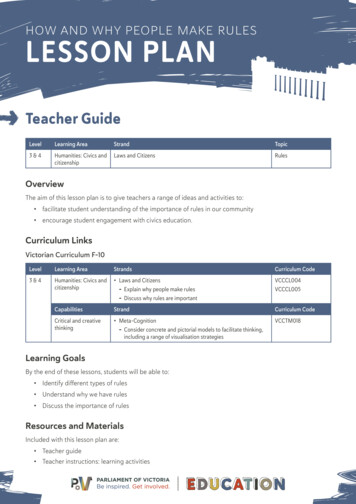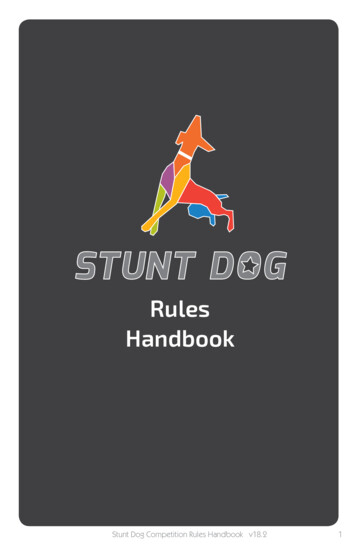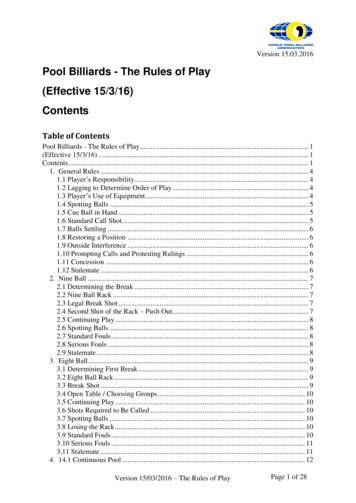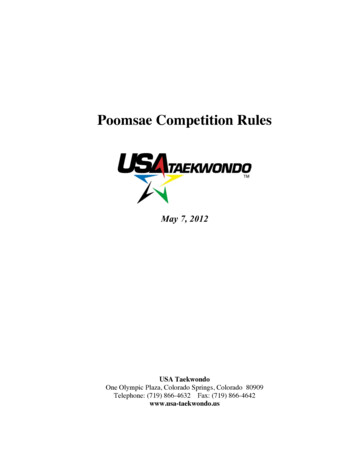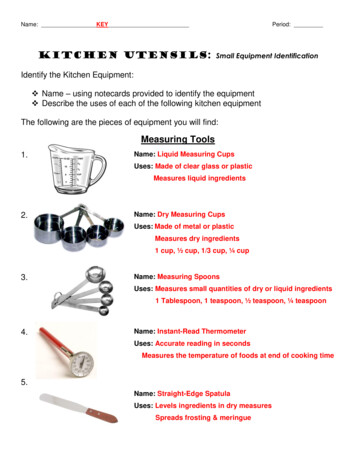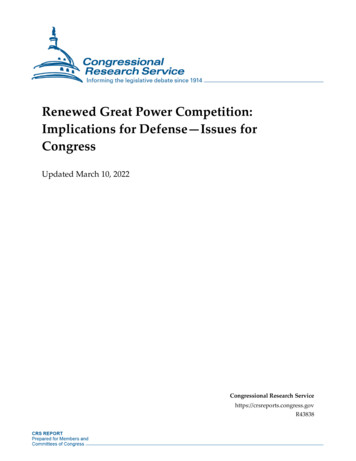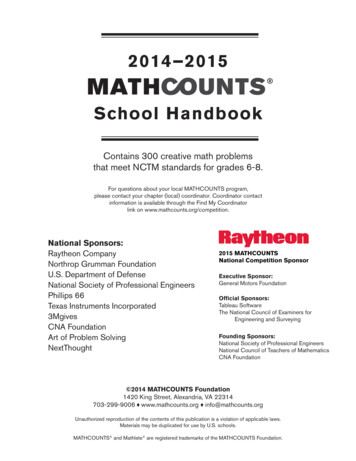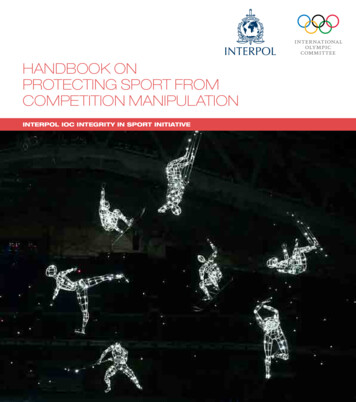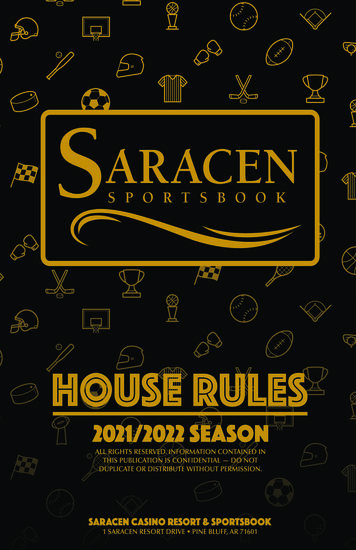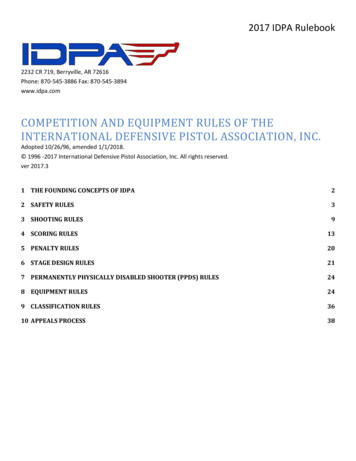
Transcription
2017 IDPA Rulebook2232 CR 719, Berryville, AR 72616Phone: 870-545-3886 Fax: 870-545-3894www.idpa.comCOMPETITION AND EQUIPMENT RULES OF THEINTERNATIONAL DEFENSIVE PISTOL ASSOCIATION, INC.Adopted 10/26/96, amended 1/1/2018. 1996 -2017 International Defensive Pistol Association, Inc. All rights reserved.ver 2017.31 THE FOUNDING CONCEPTS OF IDPA22 SAFETY RULES33 SHOOTING RULES94 SCORING RULES135 PENALTY RULES206 STAGE DESIGN RULES217 PERMANENTLY PHYSICALLY DISABLED SHOOTER (PPDS) RULES248 EQUIPMENT RULES249 CLASSIFICATION RULES3610 APPEALS PROCESS38
2017 IDPA Rulebook1 THE FOUNDING CONCEPTS OF IDPAFounded in 1996, the International Defensive Pistol Association (IDPA) is the governing body for IDPA competition, ahandgun-centric shooting sport based on simulated self-defense scenarios.The IDPA competition format was designed to be enjoyable for all shooters of all skill levels, with a premium put on thesocial interaction and camaraderie of the members. Participation in IDPA matches requires the use of handguns, holstersand other equipment suitable for concealed carry self-defense. With that in mind, and keeping the shooters' bestinterests in mind, IDPA's founders established equipment requirements that are based on commonly available firearmsand gear, allowing individuals the opportunity to compete with minimal investment.Today, thanks to the vision of its founders and a commitment to serving the organization's loyal membership, IDPAstands as the fastest growing shooting sport in the United States with over 25,000 members from all 50 states, and over400 affiliated clubs hosting weekly and monthly competitions, and membership representing over 70 nations.Our main goal is to test the skill and ability of the individual. Equipment that is designed with no application for daily,concealed carry is not permitted in this sport.1.1IDPA’s Fundamental PrinciplesThe Fundamental Principles are a guide to all members.A. Promote safe and proficient use of firearms and equipment suitable for concealed carry self-defense.B. Offer a practical shooting sport encouraging competitors to develop skills and fellowship with like-mindedshooters.C. Provide a level playing field for all competitors that solely tests the skill and ability of each individual, not theirequipment.D. Provide separate divisions for equipment and classifications for shooters, such that firearms with similarcharacteristics are grouped together and people with similar skill levels compete against each other.E. Provide shooters with practical and realistic courses of fire, and test skills that could be required to survive lifethreatening encounters.F. Strongly encourage all IDPA members to support our sponsors when making purchases of equipment andaccessories. Industry sponsors have been instrumental in IDPA’s success at all levels including Club, State,Regional, National, and International levels.G. Develop and maintain an infrastructure that will allow IDPA to be responsive to our shooters. While IDPA cannever be all things to all people, respectful constructive suggestions from our members, which follow IDPAFundamental Principles, will always be welcome.1.2Principles of Shooting IDPA1.2.1 Equipment PrinciplesAllowed equipment will meet the following criteria:A. Concealable: All equipment (except flashlights) will be placed so that it is not visible while wearing aconcealment garment, with your arms extended to your sides, parallel to the ground.B. Practical: All equipment must be practical for all day concealed carry self-defense, and worn in a manner that isappropriate for all day continuous wear.1.2.2 Participation PrinciplesA. Competitors will not attempt to circumvent or compromise any stage by the use of inappropriate devices,equipment, or techniques.B. Competitors will refrain from unsportsmanlike conduct, unfair actions, and the use of illegal equipment.C. The IDPA Rulebook is not intended to be an exhaustive description of all allowed and disallowed equipment andtechniques. Shooter equipment and techniques should comply with the basic principles of IDPA and be valid inthe context of a sport that is based on self-defense scenarios. A reasonable application of common sense and2rev 2017.3
2017 IDPA RulebookD.E.F.G.H.I.J.1.2.3A.B.C.D.the IDPA Founding Concepts will be employed in determining whether a device, technique, or piece ofequipment is permitted under the IDPA rules.At its core, IDPA is a self-defense scenario based sport. The props used to create the Course of Fire (CoF) areoften incomplete but represent buildings, walls, windows, doorways, etc. The CoF will indicate availableshooting positions. The props will be defined in the CoF walk through.Individual rehearsals of a CoF, including air gunning and taking sight pictures, are not permitted within the CoFboundaries.Shooting from behind cover is a basic premise of IDPA. Competitors will use all available cover in a CoF.IDPA is a shooting sport based on concealed carry. All courses of fire will be shot using a concealment garmentunless stipulated otherwise.In any single contest, a shooter must use the same firearm on all stages unless the firearm becomesunserviceable.Re-shoots are allowed for stage equipment failures or SO interference.English is the official language of IDPA. Range commands used in all matches regardless of location or nationalityof participants, will be in English. The English rulebook prevails.Course of Fire PrinciplesOne issue critical to the long-term success of this shooting discipline is that problems shooters are asked to solvemust reflect self-defense principles. The IDPA founders agreed upon this when they set out to structure IDPAguidelines and principles. IDPA should help promote basic sound gun handling skills and test skills a personwould need in a concealed-carry encounter. Requirements such as the use of cover while engaging a target,reloading behind cover, and limiting the number of rounds per string were all based upon that principle. “String of Fire” refers to a section of the course of fire that is initiated by a start signal, and ends withthe last shot fired. There may be more than one string in a stage. “Cover” refers to a position where a shooter can engage targets with a portion of their upper and lowerbody behind an object such as a wall.A CoF should test a competitor’s shooting skills. Allowances will be made for physically challenged or disabledshooters. Match Directors should always attempt to make the CoF accessible for all shooters.While we recognize that there are many schools of thought in training for self-defense concealed carry, theprimary focus of IDPA is in the continuing development of safe and sound gun handling skills that are universallyaccepted.IDPA rules will be equally enforced for all classifications of IDPA members.2 SAFETY RULES2.1Cooper's Four Basic RulesColonel Jeff Cooper’s Four Basic Rules of Firearm Safety have appeared in the beginning pages of books, videos, andtraining courses for more than 30 years. They are time honored and although they are not IDPA safety rules, they serveas the foundation of the safety rules below. All guns are always loaded.Never let the muzzle cover anything you are not willing to destroy.Keep your finger off the trigger till your sights are on the target.Identify your target, and what is behind it.The Safety Rules below serve as the cornerstone for every IDPA shooter to follow, including Safety Officers (SOs), MatchDirectors (MDs), and Area Coordinators (ACs), so that our events are safe and enjoyable to a wide range of participants.They are to be adopted for all IDPA events.3rev 2017.3
2017 IDPA Rulebook2.2Unsafe Firearm HandlingUnsafe firearm handling will result in immediate Disqualification (DQ) from an IDPA match. The following is a nonexclusive list of unsafe behaviors.A. Endangering any person, including yourself. This includes sweeping one’s self or anyone else with a loaded orunloaded firearm. Sweeping is defined as allowing the muzzle of the firearm (loaded or unloaded) to cross orcover any portion of a person.Exception: Some body types combined with some holster types makes it almost impossible to holster a firearmor remove the firearm from the holster without sweeping a portion of the shooter’s lower extremities. Thus, amatch Disqualification is not applicable for sweeping of the shooter’s own body below the belt while removingthe firearm from the holster or holstering of the firearm, provided that the shooter’s trigger finger is clearlyoutside of the trigger guard. However, once the muzzle of the firearm is clear of the holster on the draw,sweeping any part of the body is a Disqualification. Example: Sweeping one’s leg on a seated start is a DQ.B. Pointing the muzzle beyond designated “Muzzle Safe Points” if used, or beyond the 180-degree Muzzle SafePlane if used.C. Intentionally engaging (discharging the firearm) anything other than a target or an activator.D. A discharge:a. in the holster.b. striking up range of the shooter.c. into the ground downrange closer to the shooter than 2 yards, unless engaging a low target that iswithin 2 yards.d. over a berm.e. during Load And Make Ready, Unload and Show Clear, Reload, or Malfunction Clearance.f. before the start signal.g. while transferring a firearm from one hand to the other.h. while handling a firearm except at the firing line.E. Removing a firearm from the holster, unless:a. With verbal instruction from a SO.b. While engaging targets in a CoF under the direct supervision and visual contact of a SO.c. When in a designated “Safe Area”.F. Pointing the muzzle over the berm during the “Pull the Trigger” portion of Unload and Show Clear.G. Drawing a firearm while facing up range.2.3Dropping A Firearm2.3.1Dropping a loaded or unloaded firearm or causing it to fall, during Load And Make Ready, the shooting of astring or stage, reloads or malfunction clearance or during Unload and Show Clear will result in disqualificationfrom the match. If a shooter drops a firearm, the SO will immediately give the command “Stop”. The SO will pickup/recover the dropped firearm and render it safe and unloaded before returning it to the shooter. The shooterwill be disqualified from the IDPA match.If a shooter drops a loaded or unloaded firearm or causes it to fall within a stage boundary, the shooter isdisqualified from the match.Dropping an unloaded firearm or causing it to fall while outside of stage boundaries is not within IDPA’s control,and is subject to local Range policy.2.3.22.3.32.4Ear and Eye Protection2.4.1Ear protection and impact resistant eye protection are required to be used by everyone attending an IDPAshooting event. The responsibility for safe and serviceable ear and eye protection falls completely on theshooter or spectator. IDPA recommends that hearing protection have a minimum 21dB NRR rating and that eyeprotection have a minimum ANSI Z87.1 impact rating and side shields.The SO will stop a shooter that has started a CoF and is not wearing proper eye or ear protection, and a reshoot2.4.24rev 2017.3
2017 IDPA Rulebook2.4.3will be given to the shooter. If the shooter’s eye or hearing protection becomes dislodged during a CoF, thesame action applies. If the shooter discovers missing or dislodged eye or hearing protection before the SO andstops, the shooter will also be given a reshoot.A shooter who intentionally loses or dislodges eye and/or ear protection during a CoF will be disqualified.2.5Pistol ServiceabilityPistols used in competition will be serviceable and safe. The responsibility for safe and serviceable equipment fallscompletely on the shooter. The MD will require a shooter to withdraw any pistol or ammunition observed to be unsafe.In the event that a pistol cannot be loaded or unloaded due to a broken or failed mechanism, the shooter must notifythe SO, who will take such action as he/she thinks safest.2.6FingersFingers must be obviously and visibly outside the trigger guard during loading, unloading, drawing, holstering, whilemoving (unless engaging targets) and during malfunction clearance.A. First offense is a Procedural Error penalty.B. Second Offense is a DQ from the match.C. Each “Finger” violation will be clearly noted on the shooter’s score sheet for tracking purposes.2.7Pistol Carry ConditionThe normal condition of pistols not in use during a CoF is holstered and unloaded, with hammer down or striker forwardand magazine removed or cylinder empty. Magazines, speed loaders, and moon clips may be reloaded while off thefiring line, but the shooter’s firearm can be loaded or unloaded only under the direction of the SO. (See the rule belowregarding Cold Ranges, Hot Bays, and Hot Ranges.)2.8Start ConditionsAll CoFs will be started with the pistol holstered, safeties engaged as required by different divisions, and hands clear ofequipment including the concealment garment unless other positions for the pistol are stipulated in the written stagedescription (table top, drawer, pack, purse, in the firing hand, etc.).2.9Muzzle SafetyThere are three types of muzzle safe area indicators used in IDPA. The written stage description will describe which typeof muzzle safe point is used or if the two types are used in concert. One or both may be used on a single stage, howeverif no muzzle safe cones or flags are present on a stage, the default is the 180 rule.A. Muzzle Safe Points: A Muzzle Safe Point is a physical and clearly visible marker such as a traffic cone or stake inthe ground with a brightly colored flag or marker tape attached.5rev 2017.3
2017 IDPA RulebookB. 180-Degree Plane: The 180 plane is an imaginary infinite vertical plane drawn through the centerline of theshooter’s body, perpendicular to the centerline of the shooting bay that moves with the shooter as the shootermoves through the stage. When facing downrange, the violation of the 180-degree plane when drawing from amuzzle rearward holster configuration or while holstering a firearm into a muzzle rearward holster configurationis not an infraction.If the muzzle of the shooter’s firearm points further up range than a “Muzzle Safe Point” the shooter will bedisqualified from the match. The shooter will be given the command “Stop.” The shooter will stop immediately,place the trigger finger obviously and visibly outside the trigger guard of the firearm, and wait for furtherinstructions from the SO.C. Muzzle Exclusion ZoneMuzzle Exclusion Zones must be marked on doors that the shooter is required to open during the CoF. This typeof muzzle safe point designates a keep out area and should be a minimum dimension of 6” square. If the muzzlepoints at this keep out area while the shooter is touching the door knob/handle, the shooter will be disqualified.2.10 Safe AreasSafe Areas must be provided for all local and Sanctioned matches, in convenient locations and in numbers adequate tohandle the volume of expected shooters. A Safe Area is defined as a designated area where the following rules apply:6rev 2017.3
2017 IDPA RulebookA. Each Safe Area must be clearly identified by visible signage, and include a table with the safe direction andboundaries clearly shown.B. Unloaded firearms may be handled at any time. This area is used for bagging or un-bagging a firearm, holstering,drawing, dry firing, or equipment adjustment.C. A Safe Area may also be used for inspections, stripping, cleaning, repairs, and maintenance of firearms,ammunition feeding devices, or related equipment.D. The muzzle of the firearm must be pointed in a safe direction.E. Handling of ammunition, loaded ammunition feeding devices, loose rounds, dummy ammunition, snap caps,simunitions, training rounds, or loaded firearms is not permitted in safe areas.F. A Safe Area may also be used, while accompanied by a SO, to render safe a firearm that has locked up andcontains a live round or rounds.G. Reload practice within the Safe Area is not allowed. An empty magazine may be inserted into a firearm to testfunctionality or to drop the hammer on a firearm with a magazine disconnect, but reload practice is prohibited.The violation of any of the cases above will result in disqualification from the match.2.11 Hot and Cold RangesThe question of Hot and Cold ranges at the local club level is subject to individual club policy. This issue is the soleresponsibility of local clubs and is beyond IDPA’s control. Matches sanctioned by IDPA are required to operate under theCold range rule, but may use Hot Bays if desired.2.11.1 Cold RangeA “Cold Range” is defined as a range where all firearms must be unloaded unless under the direct supervision of a SO.2.11.2 Cold Range with Hot BaysA “Cold Range with Hot Bays” is defined as a range that does not allow loaded firearms in the holster outside of theshooting bays but does allow for loaded firearms in the holster within the shooting bays as directed by and under thesupervision of the SOs. Loaded firearms may only be handled while on the firing line when the shooter is given specificRange Commands and is under the direct supervision of a SO.With direct supervision from the SO, and when given specific Range Commands, an entire squad of shooters will line upacross the bay, face down range and will “Load And Make Ready” as a group.The perimeter of the bay will be well defined as well as any area designated as a "Safe Area" where handling ofammunition and loaded firearms is not permitted. A procedure for requesting to be unloaded to exit the bay will beestablished by the CSO and explained to all participants during the stage briefing. If a shooter for any reason needs toleave a Hot Bay, the shooter must contact one of the SOs in that bay to safely unload the firearm before leaving the bay.If a shooter for any reason does not wish to load his firearm with the group, the shooter is not to be penalized.2.11.3 Hot RangeA Hot range is defined as a range where each shooter has the choice to carry a loaded firearm at any time. Loaded orunloaded firearms may only be handled while on the firing line and under the direct supervision of a SO.2.12 Range CommandsMany of the range commands given to a shooter by the SO are for safety, while the rest are for stage administration.To allow a shooter to compete anywhere in the world and hear the same commands, the IDPA range commands willonly be given in English, the official language of IDPA. These exact range commands must be used and local variationsare not allowed.The complete set of IDPA Range Commands are:2.12.1 Range Is Hot - Eyes & EarsThis is the first command given to each shooter starting the action of shooting a stage. This command signifies the startof the CoF. The shooter will make sure that their eye and hearing protection is in place. It is also notification to anyone inthe shooting bay to check that their own eye and hearing protection is properly fitted.7rev 2017.3
2017 IDPA Rulebook2.12.2 Load and Make ReadyWhen the shooter has proper eye and hearing protection, the SO will issue the Load and Make Ready command. Theshooter will prepare the firearm and magazines to match the start position for the stage. Typically, this is to load thefirearm and holster, but may include non-typical loading or staging of equipment. The shooter will then assume thestarting position necessary for the stage. If the shooter’s firearm is not to be loaded for the start of a stage the commandused will be “Make Ready.”2.12.3 Are You Ready?After “Load and Make Ready,” the SO will ask the shooter “Are You Ready?” If ready, the shooter should respondverbally, or by obvious nodding of the head, but may also choose to stand ready. If there is no response from theshooter in approximately 3 seconds, the shooter is assumed to be ready.If the shooter is not ready when this question is asked the shooter must respond “Not Ready”. If the shooter continuesto not be ready, the shooter must take a step out of the starting position. When ready, the shooter will assume thestarting position and the “Are You Ready” question will be asked again.The shooter is expected to be ready to proceed approximately 15 seconds after the “Load And Make Ready” command.If the shooter is ill prepared and needs more than fifteen seconds to get ready, the shooter will be advised that he/she isbeing given approximately 15 seconds more to prepare. If the shooter is still not ready after that period, he/she willreceive a Procedural Error penalty and will be moved down in the shooting order.2.12.4 StandbyThis command is given after the shooter is ready. This command will be followed by the start signal within 1-4 seconds.The shooter may not move or change positions between the “Standby” command and the start signal, unless required todo so by the CoF.2.12.5 FingerThis command is given when the shooter’s finger is not obviously and visibly outside the trigger guard when it should be,as noted above.2.12.6 MuzzleThis command is given when the muzzle of the shooter’s firearm is pointed near a muzzle safe point. The shooter mustcorrect the errant muzzle and continue with the stage. See muzzle safe points above.2.12.7 StopThis command is given when something unsafe has happened or is about to happen during a stage, or when somethingin the stage is not correct. The shooter must immediately stop all movement, place the trigger finger obviously andvisibly outside the trigger guard, and await further instruction. Failure to immediately stop and remove the trigger fingerfrom within the trigger guard will result in Disqualification from the match.2.12.8 If Finished, Unload and Show ClearThis command will be issued when the shooter has apparently finished shooting the stage. If the shooter is finished, allammunition will be removed from the firearm and a clear chamber/cylinder will be shown to the SO. If the shooter isnot finished, the shooter should finish the stage and the command will be repeated.2.12.9 If Clear, Slide Forward or Close CylinderOnce the SO has inspected the chamber/cylinder and found it to be clear, this command will be issued and the shooterwill comply.2.12.10 Pull the TriggerThe shooter will point the firearm at a safe berm and pull the trigger to further verify that the chamber is clear. If thefirearm fires, the shooter will be disqualified from the match. This requirement also applies to firearms with a de-cockeror magazine disconnect. For firearms with a magazine disconnect, an empty magazine, or dummy magazine must beinserted before the trigger is pulled, and then removed again. This command is not needed for revolvers.2.12.11 HolsterThe shooter will safely holster the firearm.8rev 2017.3
2017 IDPA Rulebook2.12.12 Range is ClearThis command indicates to everyone within the stage boundaries that the range is clear. This command ends the CoFand begins the scoring and resetting of the stage.2.13 Club Safety RulesClubs or Ranges that host IDPA matches may have additional or more restrictive safety requirements. These safetyrestrictions will be accommodated by the IDPA MD and staff provided that they do not interfere or conflict with thePurpose and Principles of IDPA or the administration of the match according to the IDPA Safety Rules. Any additionalrestrictions or requirements must be published in all Sanctioned Match announcements and visibly displayed at thematch in a location accessible to the shooters.2.14 Steel TargetsSteel Targets must be engaged from 10 yards or more. If a shooter engages a steel target from less than 10 yards theshooter will be disqualified.2.15 General MaintenanceThe MD should make every effort to ensure that all items used in an IDPA match are in good condition and safe as used.This includes permanent fixtures in the shooting bay, the bays themselves, berms, props, static and moving targets,target holders, doors, walls, barrels, tables, reactive targets, etc.3 SHOOTING RULES3.1Concealment GarmentsA concealment garment is required for all stages unless otherwise specified in the stage description. This includesstandards and limited stages.Police or military personnel may use actual duty gear in Tier 1 matches. See definition of duty gear in the EquipmentSection. Use of duty gear eliminates concealment requirements.3.2Target Engagement3.2.13.2.2All targets must be engaged in tactical priority, including all targets engaged “in the open.”Tactical Priority is method of target engagement in which targets are engaged by their order of threat. Threat isbased on the distance of the visible threats from the shooter. Targets are considered equal threat when thedifference in the target distances to the shooter is less than 2 yards.If several targets are visible at the same time, targets are engaged from near-to-far unless they are equal threat.If targets are hidden by cover, the targets are engaged as they become visible around the edge of cover (slicingthe pie).A target is considered “Engaged” when:A cardboard target is deemed to have been engaged when the required number of shots for that target havebeen fired at the target.Body and head shots may be required on an individual visible cardboard target and must be shot in the orderand quantity stipulated in the CoF. Failure to shoot one or more targets in the required body then head orderearns the shooter a single PE.A reactive target is deemed to have been engaged when a minimum of 1 round is fired at the target, regardlessof whether the target reacts. All penalties apply if the shooter does not re-engage the target until the targetreacts or if the shooter unsuccessfully challenges the reactive target calibration.A cardboard target with a steel activator behind it is considered engaged when the required number of shots arefired at the cardboard target.When an activator reveals a target of equal or higher Tactical Priority, the shooter may interrupt the3.2.33.2.43.2.5A.B.C.D.3.2.69rev 2017.3
2017 IDPA Rulebookengagement of the cardboard target to engage the target of equal or higher Tactical Priority without retreating.3.2.7 Target engagement penalties shall not apply in the following cases:A. A shooter may not be penalized for failing to fire the required number of shots at a disappearing target.B. When engaging a target array of equal priority, the shooter may not be penalized based on the shooter’s orderof target engagement.C. Targets may be re-engaged from other shooting positions provided the shooter does not break the definedMuzzle Safe Points see section 2.9.3.3Walkthroughs3.3.1Prior to shooting a stage, a group walkthrough will be given by the SO. During the group walkthrough, the SOwill verbally indicate to all shooters the vision barriers and points of cover for each target and fault lines. Duringthe group walkthrough, the SO will also indicate to shooters all special conditions for the stage. Each shooter willbe allowed to view each target from every shooting position. This includes taking a knee or going prone.Other than the group walkthrough, no individual stage walkthroughs are permitted. Individual walkthroughsinclude walking the path of fire or assuming shooting positions for the purpose of check cover positions or targetengagement, order, etc.Air gunning and/or sight pictures are not permitted. Air gunning is the act of going through the motions of firingall or portions of the stage with a hand or pointed finger while within the stage boundaries. A sight picture is theact of drawing a loaded or unloaded firearm and aiming it downrange before the start signal to begin a stage.Stage Boundaries mark the region wherein the shooter becomes subject to the rules of air gunning, sight pictureand an individual walkthrough.3.3.23.3.33.3.43.4Reloads3.4.1An "emergency reload" is when the magazine/cylinder and the chamber are both empty in the firearm, and isthe preferred reload for IDPA competition.3.4.2 The shooter initiates a reload by performing any one of the following actions:A. Withdrawing a magazine, speed loader or moon clip from a carrier, pocket or waistband.B. Activating the magazine release on a semi-auto pistol (as evidenced by the magazine falling from the firearm)C. Opening the cylinder of a revolver.3.4.3 A firearm is deemed to be reloaded when the magazine is seated and the slide is in battery or the revolvercylinder is closed. The firearm must contain at least one unfired cartridge in the chamber, magazine, or cylinder.3.4.4 If the shooter “drops” or "racks" the slide prior to leaving a Position of Cover and the slide fails to go fully intobattery, this must be considered a malfunction and no penalty shall be assessed.3.4.5 A firearm is deemed empty when there is no live ammunition in the chamber or magazine for semi-autos, orthere is no live ammunition in the cylinder for revolvers.3.4.6 Shooters may not perform a reload which results in a magazine (or loose rounds) being left behind after therewas an unfired cartridge in the chamber, magazine, or cylinder at the time the reload was initiated. When doneintentionally, this is commonly known as a “speed reload”, but doing this unintentionally is still illegal and willresult in a Procedural Error penalty being issued.3.4.7 Dropping a loaded magazine or speed loader/moon clip does not incur a penalty as long as the shooter retrievesand properly stows the loaded magazine or speed loader/moon clip prior to the firing of the last shot in thestring of fire.3.4.8 When clearing a malfunction, the magazine or speed loader/moon clip and/or ammunition that may havecaused the malfunction does not need to be retained by the shooter and will incur no penalty if dropped.3.4.9 A shooter may not remove a loading device after the start signal and stage it (e.g. toss on table, ground or holdin hand) for use later in the stage. However, the stage description may specify staging loading devices prior tothe start signal for all shooters as part of the CoF. Firearms must start from the mechanical condition of10rev 2017.3
2017 IDPA Rulebookreadiness appropriate
2 SAFETY RULES 2.1 Cooper's Four Basic Rules Colonel Jeff Cooper’s Four Basic Rules of Firearm Safety have appeared in the beginning pages of books, videos, and training courses for more than 30 years. They are time honored and although they are not IDPA safety rules, they serve as t
